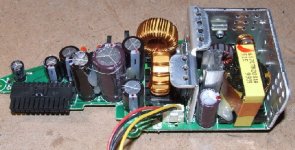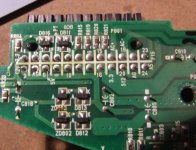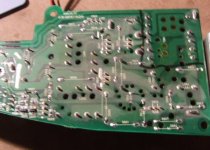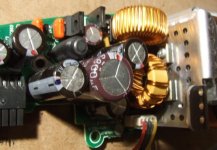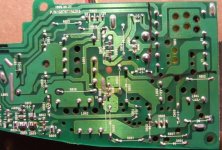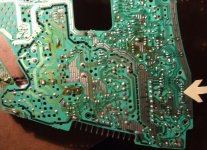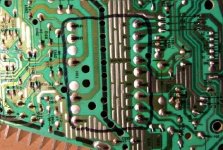Ok guys, I need your help.
My iMac's CRT monitor died today, so I'm going to recase it as per the many mods out there on the web. That bit's no problem. However,all the mods I can find use an ATX power supply, and I'm a cheapskate and want to recycle as much of this as possible.
So, the iMac logic card uses a downconverter, pic below, to convert 24AC to the various DC levels required. However, I assume that this is already switched from mains voltage, so that 24V will be running at a much higher frequency than mains 50Hz. So, my question. Is it possible to reuse the big traffo from the main PSU and create a simple switching front end to drive it at the higher frequency required?
Thanks in advance. 🙂
My iMac's CRT monitor died today, so I'm going to recase it as per the many mods out there on the web. That bit's no problem. However,all the mods I can find use an ATX power supply, and I'm a cheapskate and want to recycle as much of this as possible.
So, the iMac logic card uses a downconverter, pic below, to convert 24AC to the various DC levels required. However, I assume that this is already switched from mains voltage, so that 24V will be running at a much higher frequency than mains 50Hz. So, my question. Is it possible to reuse the big traffo from the main PSU and create a simple switching front end to drive it at the higher frequency required?
Thanks in advance. 🙂
Attachments
It looks like a flyback so it may work with DC input too. Can you provide more detailed pictures including the bottom side of the PCB?
Thanks Eva.
I'll post some more pics in a bit, but I just had to put my camera on charge. I suspect it needs AC though as the input goes directly to the legs of the big transformer on the right.
I'll post some more pics in a bit, but I just had to put my camera on charge. I suspect it needs AC though as the input goes directly to the legs of the big transformer on the right.
You've got a prehistoric iMac, back in the dark days of OS9. I've got some service manuals, which generation is it? The manuals won't go as deep as you want, but may be helpful.
Have you considered a refurbished mini? You can run OS X and windows, and it's all in a small tidy package already. Hard to beat if you consider the cost of your time.
Sheldon
Have you considered a refurbished mini? You can run OS X and windows, and it's all in a small tidy package already. Hard to beat if you consider the cost of your time.
Sheldon
stokessd said:I've got some service manuals, which generation is it?
It's the first version of the slot loading DV, I found a pdf of the service manual online, but as you say, it doesn't really go into enough detail, "Take this board out and order a replacement from us "doesn't really cut it.
... Hard to beat if you consider the cost of your time...
I'm "between jobs" at the moment, so time is plentiful, but cash is short. 😉
Not that I'm trying to get you to not rebuild your computer, but have you checked on ebay? The CRT imac units are always selling for like $40. I thinking it would be hard to repackage and get a working CRT for the same price.
Sheldon
Sheldon
Member
Joined 2002
I don't want to offer something that might not happen. But I CAN bet that if you ask planet10 for one youll get one for xmas 😀 He has so many of them. My therory never hurts to ask, the worst some one will say is no D:
stokessd said:The CRT imac units are always selling for like $40. I thinking it would be hard to repackage and get a working CRT for the same price.
Sheldon
In the UK, they go for around £60-£100!
Anyway, pic of the underside by the input/output connector:
Attachments
Member
Joined 2002
Thanks Jason, but the problem is not with that board, I just need to get high frequency 24V ac into it, normally provided by the huge iMac PVB, (power and video board, but don't let the video bit distract you, it means CRT driver stuff).
Hi pinkmouse, can you provide a better quality version of the picture from post 9? The dirt and the fact that it's out of focus is preventing me to see most of the tracks. It may not be 24V HF as you think.
Well, it seems that they use a linear regulator for the 12V output and magnetic amplifiers for the 5V and 3.3V outputs. The transformer is then fed with high frequency AC so you were right. The AC waveform may be either unipolar (switching in one direction for 50% of time and allowing the transformer to demagnetise for the other 50% of time) or bipolar (produced by a full bridge). The frequency also remains unknown, you would have to do some bench tests in order to know how long it takes to saturate and derive a suitable frequency.
Do you still have the circuit that provided the 24V AC? A quick look at the topology would already tell me if it's unipolar or bipolar.
Do you still have the circuit that provided the 24V AC? A quick look at the topology would already tell me if it's unipolar or bipolar.
Great, this one looks like a big off-line flyback. Can you take a couple of clear pictures of the bottom side of the board? The interesting portion goes from the big heatsink to the small heatsink (including it) and the edge of the square hole.
They may be slaving the other transformer to the flyback and attaching the primary of the other transformer directly to the secondary of the flyback.
Oh, and try to read the model of the big swithcing IC in the big heatsink, it will probably tell us the switching frequency.
They may be slaving the other transformer to the flyback and attaching the primary of the other transformer directly to the secondary of the flyback.
Oh, and try to read the model of the big swithcing IC in the big heatsink, it will probably tell us the switching frequency.
- Status
- Not open for further replies.
- Home
- Amplifiers
- Power Supplies
- iMac SMPS
